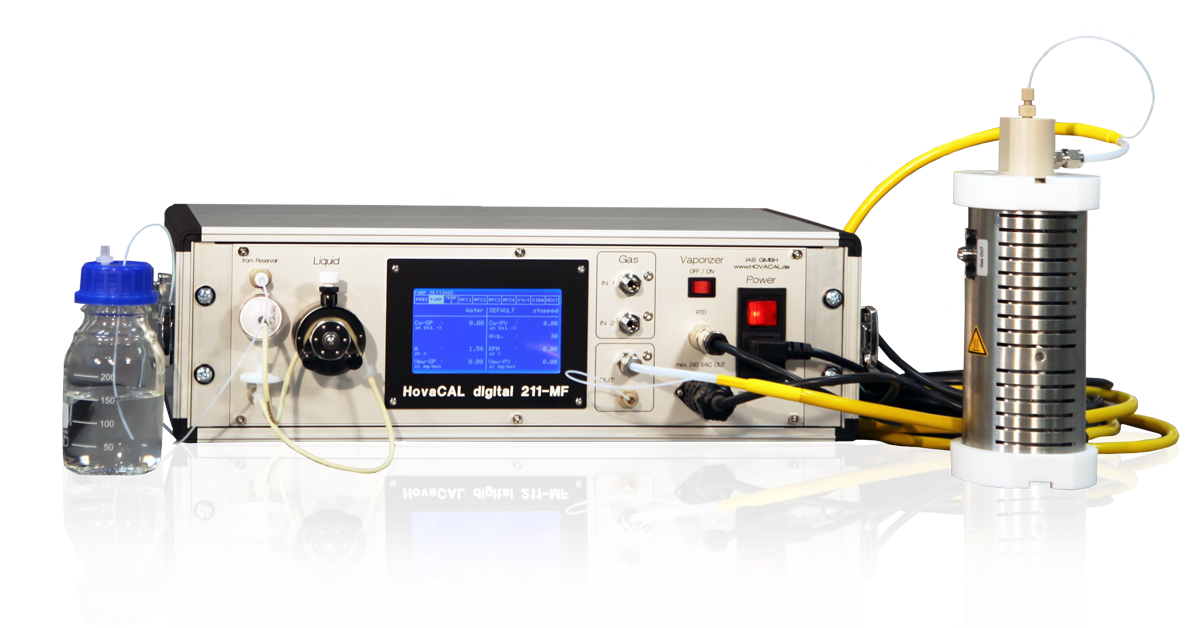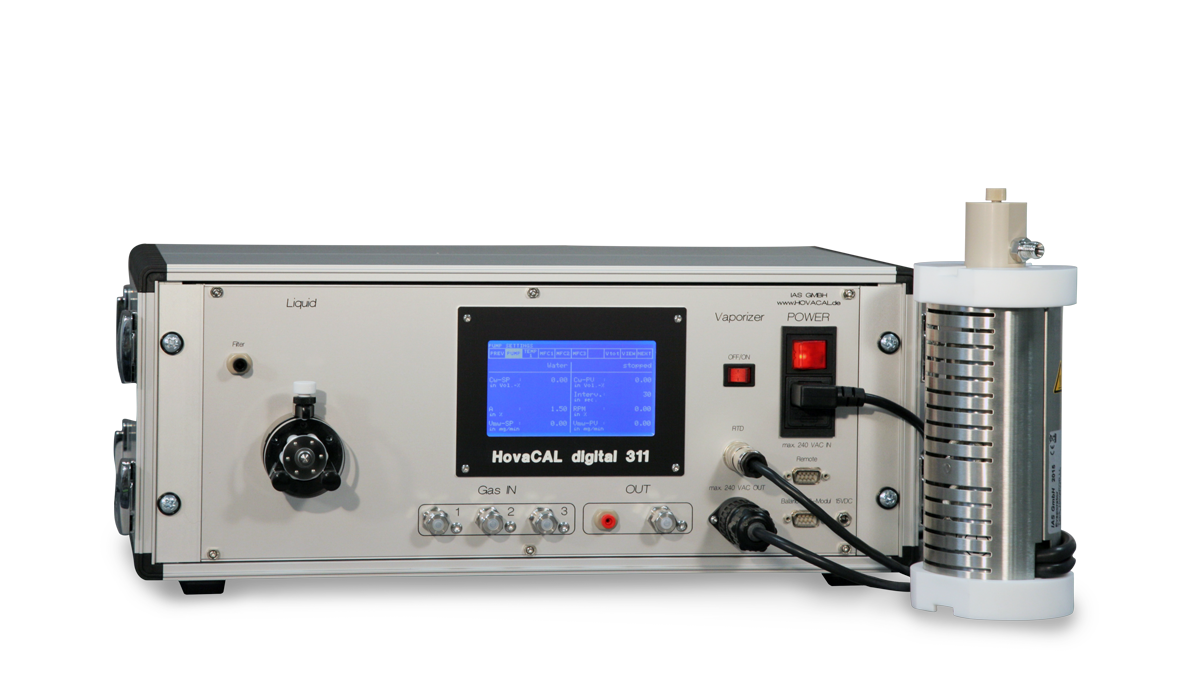HovaCAL® CALIBRATION GAS GENERATOR
HovaCAL® – the allrounder
HovaCAL® stands for Hot-Vapor-Calibration and is used to produce precise gas-vapor mixtures for checking gas analysers and gas metering systems. Using the HovaPOR special evaporator technology, HovaCAL® can evaporate and mix with carrier gas not only water, acids and alkalines, such as HCl, NH3, HF and HgCl2 but also organic solutions, continuously and without pulsations. HovaCAL® works according to the principle of continuous dosing and dynamic evaporation of liquid and mixing in of carrier gas. The concentration of the gas-vapor mixture is determined through the precise dosing of liquid and gas, as well as complete evaporation in the HovaPOR evaporator. HovaCAL® is available in different versions, depending on the application and purpose of use. For mobile use in emission monitoring, HovaCAL® consists, for example, of a supply unit and the evaporator. The supply unit is used to dose liquid and gas, as well as control and monitor the temperature of the evaporator. Mass flow meters and controllers are used to dose the medium. The liquid flow rate can also be controlled gravimetrically or volumetrically. The HovaPOR evaporator is connected to the supply unit by lines for carrier gas, liquid and electricity to the supply unit and can therefore be set up or installed separately from it. The outlet of the evaporator can be connected to a heated pipe or directly to the gas analyser or sampling system. The accuracy and reproducibility of the resulting gas-vapor mixture are ensured by a high-precision gas mass flow controller and liquid dosing pump. And when it comes to operation, there's the easy-to-use viewCAL software.
HovaCAL digital 211-MF calibration gas generator
Variants & versions
HovaCAL® is available in different variants and versions:
- as a mobile calibration gas generator for checking analysis systems on site or as a stationary unit for laboratory and test bench use
- HovaCAL® basic – our basic version with one gas channel
- HovaCAL® digital – can regulate up to five different gas flows, as well as mix them with vapors, and can be controlled remotely using the ViewCAL software
- HovaCAL® digital MF – additionally features internal liquid measurement and control HovaCAL® digital SP – equipped with a micro dosing device, also suitable for organic solvents
- HovaCAL® VOC – capable of generating extremely low concentrations of pure substances, e.g. down to the ppt range
Typical fields of application
The HovaCAL® is used to generate test gases anywhere that gas analysers need to be checked and the required test gases are not available in the right form:
- In the emission monitoring systems of waste incineration plants, power plants and cement plants. Due to the components being monitored – HCl, HF, NH3 and HgCl2, the analysis systems used are ones which can take hot measurements and which are adjusted with hot, humid test gases of these components.
- Hot gas FTIR analysers are used mainly for automotive exhaust analysis. They simultaneously measure water vapor, nitrogen oxides, ammonia, alcohols, aldehydes and other components. The corresponding test gas is generated with the HovaCAL®.
- In humidity measurement, testing is often a requirement, since conventional saturation methods often don't obtain high water vapor levels or can only be changed slowly. HovaCAL® lets you set your target humidity precisely and quickly.
- In mercury detection, which is particular to flue gas analysis due to its small measuring ranges, the HovaCAL® is used to generate mercury-containing test gases with compositions similar to flue gas.
- In workplace monitoring, electro-chemical sensors are often used. These sensors are highly sensitive to the presence of dry test gases. With HovaCAL® test gases can be humidified, as well as produced from reagent solutions with a defined humidity.
- In flammable vapor monitoring, the goal is to check gas warning systems using the solvent to be monitored. For this purpose, HovaCAL® provides the desired test gas in the desired concentration.
HovaCAL® can also be used as a gas dilutor and gas mixer, in order to set cylinder gases such as SO2, CO, CO2, NOx, O2 etc. to the desired concentration. Moreover, it's possible to humidify this gas mixture to a defined degree over a broad humidity range. This gives us test gases which are very similar to the measuring gas in its complex composition, yet are defined and controllable. Due to the elevated temperature of the resulting gas-vapor mixture, it is possible to specifically avoid adsorption and corrosion effects and thus significantly reduce the gas response time.

HovaCAL digital 211-MF with accessories

IAS HovaCAL digital 311 with evaporator
Advantages of the HovaCAL®:
- A wide range of gas components
- Low operating costs
- High accuracy thanks to mass flow technology
- Traceability to primary methods
- Functions independently of ambient pressure and temperature
- Short response time
- Adjustable humidity
- High stability of the resulting gas concentration
- Temperature-independent – due to complete evaporation
- Adjustable gas temperature
- Application-specific gases and vapors
- Point of use generation: Test gas where you need it
- Easy to transport in its carrying case for moving quickly from site to site
